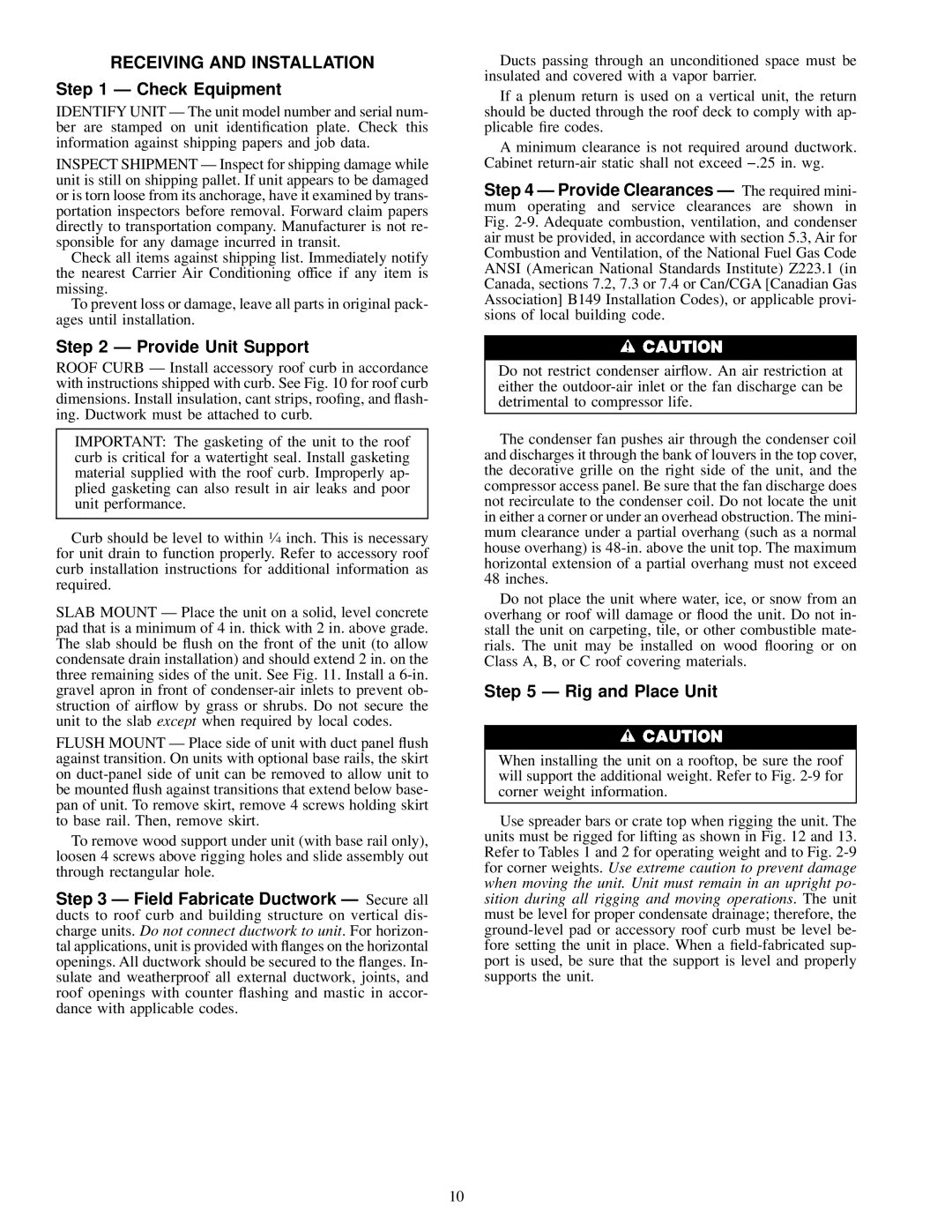
RECEIVING AND INSTALLATION
Step 1 Ð Check Equipment
IDENTIFY UNIT Ð The unit model number and serial num- ber are stamped on unit identi®cation plate. Check this information against shipping papers and job data.
INSPECT SHIPMENT Ð Inspect for shipping damage while unit is still on shipping pallet. If unit appears to be damaged or is torn loose from its anchorage, have it examined by trans- portation inspectors before removal. Forward claim papers directly to transportation company. Manufacturer is not re- sponsible for any damage incurred in transit.
Check all items against shipping list. Immediately notify the nearest Carrier Air Conditioning office if any item is missing.
To prevent loss or damage, leave all parts in original pack- ages until installation.
Step 2 Ð Provide Unit Support
ROOF CURB Ð Install accessory roof curb in accordance with instructions shipped with curb. See Fig. 10 for roof curb dimensions. Install insulation, cant strips, roo®ng, and ¯ash- ing. Ductwork must be attached to curb.
IMPORTANT: The gasketing of the unit to the roof curb is critical for a watertight seal. Install gasketing material supplied with the roof curb. Improperly ap- plied gasketing can also result in air leaks and poor unit performance.
Curb should be level to within 1¤4 inch. This is necessary for unit drain to function properly. Refer to accessory roof curb installation instructions for additional information as required.
SLAB MOUNT Ð Place the unit on a solid, level concrete pad that is a minimum of 4 in. thick with 2 in. above grade. The slab should be ¯ush on the front of the unit (to allow condensate drain installation) and should extend 2 in. on the three remaining sides of the unit. See Fig. 11. Install a
FLUSH MOUNT Ð Place side of unit with duct panel ¯ush against transition. On units with optional base rails, the skirt on
To remove wood support under unit (with base rail only), loosen 4 screws above rigging holes and slide assembly out through rectangular hole.
Step 3 Ð Field Fabricate Ductwork Ð Secure all ducts to roof curb and building structure on vertical dis- charge units. Do not connect ductwork to unit. For horizon- tal applications, unit is provided with ¯anges on the horizontal openings. All ductwork should be secured to the ¯anges. In- sulate and weatherproof all external ductwork, joints, and roof openings with counter ¯ashing and mastic in accor- dance with applicable codes.
Ducts passing through an unconditioned space must be insulated and covered with a vapor barrier.
If a plenum return is used on a vertical unit, the return should be ducted through the roof deck to comply with ap- plicable ®re codes.
A minimum clearance is not required around ductwork. Cabinet
Step 4 Ð Provide Clearances Ð The required mini- mum operating and service clearances are shown in Fig.
Do not restrict condenser air¯ow. An air restriction at either the
The condenser fan pushes air through the condenser coil and discharges it through the bank of louvers in the top cover, the decorative grille on the right side of the unit, and the compressor access panel. Be sure that the fan discharge does not recirculate to the condenser coil. Do not locate the unit in either a corner or under an overhead obstruction. The mini- mum clearance under a partial overhang (such as a normal house overhang) is
Do not place the unit where water, ice, or snow from an overhang or roof will damage or ¯ood the unit. Do not in- stall the unit on carpeting, tile, or other combustible mate- rials. The unit may be installed on wood ¯ooring or on Class A, B, or C roof covering materials.
Step 5 Ð Rig and Place Unit
When installing the unit on a rooftop, be sure the roof will support the additional weight. Refer to Fig.
Use spreader bars or crate top when rigging the unit. The units must be rigged for lifting as shown in Fig. 12 and 13. Refer to Tables 1 and 2 for operating weight and to Fig.
10
